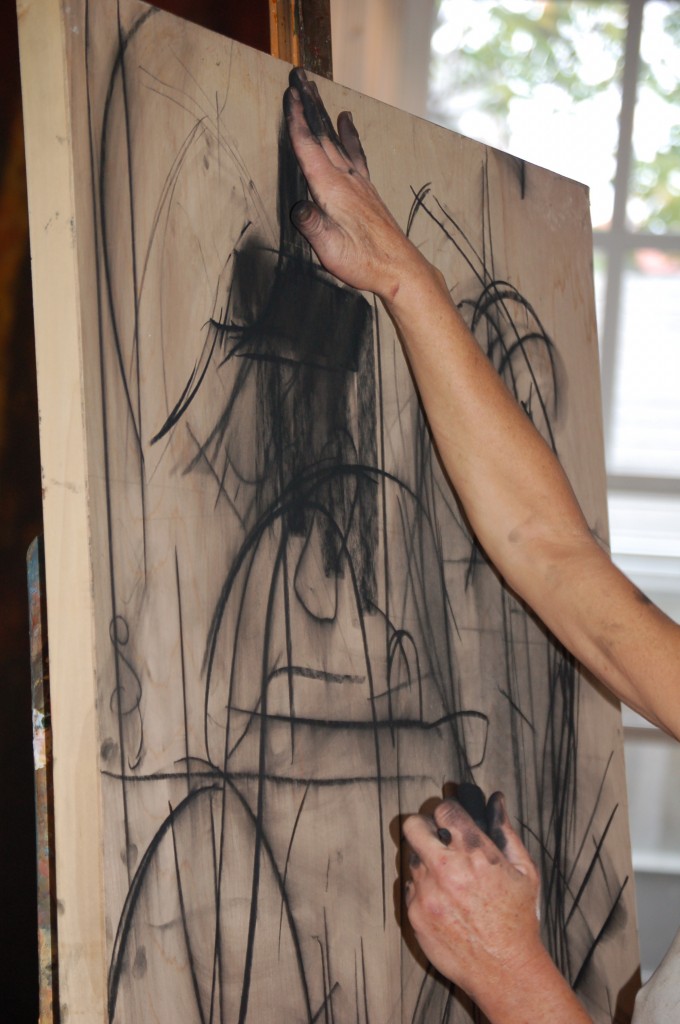
I love Cynthia Packard’s work. It’s multi-faceted. She comes from a family of painters: her mother, Anne Packard is also a nationally known artist whose enigmatic and classical seascapes always engage the viewer. Cynthia’s grandfather was Max Bohm.
Packard’s work is constantly changing. She is able to suggest representational images in a contemporary style and context, with a full and pure color palette of abstractions. Her style is loose, strong, confident and bold. She mixes mediums that provide great visual interest.
I had been on a waiting list for a Cynthia workshop. So when Leslie Packard emailed the notice of the Provincetown, October three day intensive workshop I was hooked. The prospect of participating in an intensive painting studio with a fantastic artist was exciting and daunting: you expect to learn a lot, stretch your boundaries and receive direct feedback and critiques from the instructor, while working alongside other painters. Our supply list included our easels, all paints, 12-15 canvases and our vulnerability.
Cynthia is a dynamic painter who is fully engaged and interactive while drawing, observing and painting. She is passionate about what she sees. We had wonderful models, still life arrangements and light to work with.
My goal was to learn how to stay looser with the “canvas” (she paints on board) and to learn new ways to engage the full canvas and areas within my visual viewfinder. It is too easy to zoom into one’s picture and focus on smaller elements, and I wanted to learn a new approach.
Cynthia’s Primary instructions throughout the 3 days:
- Line Drawing: Quickly establish 3 major lines/axis that are significant to you and mark them firmly on your canvas. They must traverse the whole length of image area so that you connect to all 4 edges. Add simple indicative lines, as needed, but GO TO PAINT ASAP. If one draws too much on canvas, you get over invested in the drawing and will be less likely to change the image as needed. Changing the image is easy if you allow flexibility.
- Color, line and shape.
- Geometric against organic, color against color, shape next to shape.
- Paintings need:
- Emotion
- Plasticity (as in elasticity)
- Tension (same is needed for a good musical piece; fluid tone and syncopation work when paired with measures that have solid beats and repeated structure). Use accents of deep darks and lights.
- Dynamic brushstrokes
- Clear color. Cynthia mixes each color fully before painting. She does not use paint smears of color or color blending as she feels that the strongest, clear color is rendered when it is consistently presented pigment. An object, highlight or shadow must always be a shape, rather than simply a highlighted edge. And each shape must touch another specific shape. One might say the approach borrows from the principles of cubism, which, utilizes shapes to describe all aspects of an image.
Guiding Principles:
- You must love paint in order to paint freely. Her work involves the love of paint, of mixing colors, of physically working with the paint.
- There is no “background” in PAINTING AS ALL PARTS OF THE CANVAS ARE EQUALLY IMPORTANT.
- “Talent is fearlessness”: Try new things and take risks.
- Paintings have abstract planes, figures, objects and light.
- Do not get stuck in one area of the painting. Each area of the canvas is as important as the figure, the objects, the light.
- Cynthia focuses on drawing & painting the air circulation around the objects and figures. Negative space is a static form but air circulation defines forms more dynamically.
- Tone your canvases in some neutral color so that you begin the painting with a welcoming pigment for other colors.
Encaustic
For the last 4 years Cynthia has used encaustic (wax) as her exclusive medium. Her approach is to mix oil paints with Dolan’s wax (a cold wax). Her paints are applied with disposable foam brushes of varying sizes (nice to eliminate use of solvents for brush cleaning). Then she heats the canvas (board, really, as canvas cannot be used, due to flammability). The wax melts with the pigment and then adheres to the board. Burnishing and shellac can be the top finishes.
Responses
I was pleased to learn this additional encaustic approach for my own work. I enjoyed painting on board as it offers a reactive surface rather than the pliable touch of canvas.
The workshop context forced me to look at edges, primary lines and color in new ways. I began to paint with a broader color range and tried new techniques. The mantras stated above have already begun to be incorporated into my new work and will help me remain expansive.
I am keeping my paints more fluid with added linseed oil. Wet paint can translate to a more fluid technique.
One thing of note: Cynthia encouraged us to experience her approach. In the days of apprentices and of great artists like Picasso, Bonnard, Monet, and Manet, artists were interested in painting in the style of their frIends. It expands your perspective. Now-a-days the approach is negatively titled “copying”. It’s a shame that a negative tone is cast upon employing the techniques of other artists as we can learn so much from others. Our individual styles are a combination of creativity, technique, amalgamated approaches, passion and fearlessness!
[slidepress gallery=’cynthia-packard-paints’]
